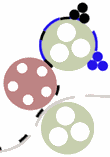The Science of Photography - Mechanical Printing |
||||||||||||||||||||||||||||||||||||||||||||||||||||||||||||||||||||||||||||||||||||||||||||||||||||||||||
The following sections describe the main mechanical printing processes currently available for reproducing photographs in publications such as books, magazines and newspapers. The majority of these printing processes need a halftone of the photographic image. This is where the different tones of the photograph are represented by many small dots of varying sizes, these appear to the eye as continuous tone. If you would like to know more about the history behind these printing processes please refer to the PhotoHistory - Photographs in Print section. The halftone process is described in detail in the PhotoScience
- Halftone Process section.
Letterpress was one of the original relief printing processes for books and newspapers. The letterpress printing surface holds the image to be printed above the non-printing background. The raised surface is inked by rollers and then paper is pressed against the printing plate to make the impression.
Letterpress was the dominant printing process for books and newspapers until the mid 1960s but now hot metal typesetting and letterpress have almost disappeared. However the use of rubber and plastic plates has greatly increased, this derivative of the letterpress is now called ‘Flexography’. The process was first invented in 1890 as a means of printing on non-absorbent materials. It was developed during the 1920’s to make use of aniline dyes derived from coal tar and the term ‘Flexography’ was first used in the 1950’s. Plates for ‘Flexography’ can be made quickly and cheaply and the relief
process has the added advantage that it does not need to maintain an ink
/ water balance, unlike lithography. Flexography is now competing with
the other printing processes for the production of cheap magazines and
paperback books.
The image on a lithographic plate is virtually flat rather than raised as in ‘letterpress’. The plate is commonly made of thin aluminium with a granular water retaining surface. The area to be printed is treated chemically so that it accepts greasy ink and rejects water, the background area accepts water but rejects the ink. The whole plate has water and then ink applied to it, when paper is pressed against this plate only the image area is printed.
Gravure is an ‘intaglio’ process, meaning that the image to be printed is recessed into the plate. A photogravure image is made up from cells of varying depth engraved into a copper-plated plate. First the cells are filled with thin sprit based ink, excess ink is removed from the plate. Paper is pressed against the plate to draw the ink from the cells, the amount of ink transferred being determined by the depth of the cell. This process gives a near continuous tone image.
In the screen printing process a synthetic or metal screen is stretched over a frame. The screen supports a stencil that has been cut by hand or made photographically. Ink is spread across the screen and squeezed through the areas not protected by the stencil. This process enables a thick film of ink to be applied to virtually any surface. 
The collotype process, also known as ‘photogelatin’, is the only process that can produce continuous tone prints without the use of screens. To produce a collotype an unscreened negative is contact printed onto a plate coated with light sensitive gelatin. The gelatin is made light sensitive by treating it with potassium or ammonium dichromate, which is often referred to as bichromate. The gelatin then hardens in proportion to the amount of light reaching it. Most light falls on the shadow areas and these become the hardest. The harder the gelatin the more capable it is of accepting ink. To prepare the plate for printing the surface is covered with a solution
of water and glycerine. The unexposed and therefore soft parts of the gelatin
are kept moist with the water and gelatine solution. These areas repel
the greasy printing ink, as in the lithography process. The degree the
ink is accepted by different parts of the plate is in proportion to the
hardness of the moist gelatin surface, the resulting collotype print is
rather like a photograph.
In the late 1850s the gum-bichromate photographic contact print process was developed by substituting gum arabic for gelatine. Although not a mechanical reproduction method gum-bichromate printing is descended from the collotype process and is worth a mention in this section. Gum-bichromate is a thick, viscous light sensitive material that responds
to light by hardening. Before exposure the gum-bichromate is dyed with
water colour paint. After exposure the print is washed in water and the
still soluble parts of the emulsion are washed away. For multi-coloured
prints a separate emulsion is prepared for each colour, a new layer is
only applied after the previous layer has dried.
In addition to the printing processes already described there are a few other mechanical printing methods, including Xerography and various digital printing processes. Xerography was invented in 1938 by Chester Carlson and then developed by the Xerox Corporation. Nowadays photocopiers are able to scan halftones and are a viable alternative to offset lithography for small print runs. Since the 1980’s the use of computers and digital imaging has greatly increased. The Photoscience - Digital Printing section describes in more detail some of the printers that are available, including laser, thermal transfer and ink jet printing. Photographs don’t need to be mechanically printed to be seen by millions of people. First there was television and now, based on software and protocols developed by Tim Berners-Lee in 1992, photographs can be seen across the world via the Internet.
Forming
the Image | Controlling
the Image | Colour
Reproduction
|
||||||||||||||||||||||||||||||||||||||||||||||||||||||||||||||||||||||||||||||||||||||||||||||||||||||||||
| Ted's Photographics |
|



